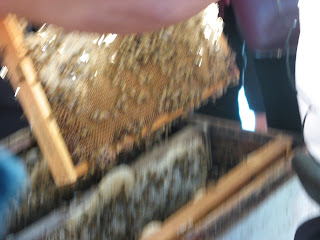 |
| Stuffed vegetables - Yong taufoo |
The fish, a natural food, is easily digested and an excellent source of high quality protein, minerals and vitamins. Doctors and nutritionists often encourage the consumption of fish to maintain good health. Some of us like our fish raw while some like it fried. A few like like it baked or grilled; many like it steamed or poached while others like it in curries or soups.
My family likes fish with creative stuffing. During family gatherings, my mother aged 80 years, often prepares stuffed fish and stuffed vegetables. During our younger days, my siblings and I looked forward to festive occasions when mother prepared her mouth-watering specialty – Fried Stuffed Fish. We called it “magic fish” because it looked like a fish but did not taste like one!
Her favourite fish for stuffing is treadfin (tai mah yau/ kurau ). I often watch with fascination my mother’s “effortless operation” in extricating the internal organs without slitting the fish’s stomach wall. She detaches the gills and then pulls them out together with innards from the stomach, a skill acquired through years of experience.
She then makes a deep cut along the fish on either side of the backbone.This results in two “pockets” for stuffing. Flipping these two flaps over gently, she scrapes the flesh without breaking the skin. The fish flesh is then finely chopped before salt water is added to it. This fish paste is then combined with a mixture of chopped meat, mushroom and water chestnut. After seasoning with pepper and cornstarch, mother stuffs the mixture back into the fish. It is quite a makeover - the fish has a “new body” in its “old clothes”.
Mother then fries the stuffed fish in shallow oil and then adds in her distinctive dark sauce. Garnished with spring onion, red chilli and cilantro, it becomes a transformed fish – our mother’s “magic fish”.
 |
| Magic fish |
To complement the stuffed fish, sometimes my mother would cook stuffed vegetables. For the paste, mum usually buys Spanish mackerel (tenggiri) or Wolf herring (ikan parang).
She removes the flesh from the fish, chops them up and adds salt water to them until they become sticky and heavy. After seasoning with pepper, cornflour, and egg white, she adds in a mixture of minced meat, salt fish and spring onion. Nowadays, we use the electric chopper and sometimes forgo the salt fish or meat.
 |
| Scrapping fish flesh |
 |
| Chopping fish flesh |
 |
| Pounding fish flesh |
Meanwhile, my sisters and I would cut the vegetables. Every piece is trimmed to mother’s specifications. The bitter gourd rings are sliced (not too thick or too thin) their seeds removed, leaving the pith tissue intact. This ensures no fish paste pops out during frying!
The brinjal is slant cut with a semi-cut in between for stuffing. The bean curd and its derivatives are treated differently: tofu, cut into triangular halves has a wedge-like pocket in the centre; taufoo pok, washed in warm water, is squeezed dry to expel the oil and then cut into half; fu chok and team chok, cleaned with a moist cloth, are cut into square bite-size pieces for easy rolling of the paste.
The red or green chilli is slit lengthwise with the seeds removed; the lady’s finger is cut similarly but with the seeds intact. The green or red pepper is cut into sections suitable for stuffing. Sometimes for variety, we include mushroom, fatt choy and chives. The mushroom stalk is removed leaving a wide surface for filling. Fatt choy is stuffed sparingly into fish balls (made from fish paste). A stalk of chives is folded in the shape of a ring and intertwined with the ends of the strand to make a little “bird nest” for filling. This vegetable finds favour with the older generation only.
Then it’s stuffing time. My sisters and I would help mother to stuff the fish paste into the cut vegetables. As we work, we catch up on the latest news of our family members. Before long, the stuffing is ready as many hands make light work.
The myriad of colours produces an attractive array – dark green, light green, apple green, red, white, brown, black and purple. This is our family’s “rainbow yong taufoo”. The stuffed vegetables (except the stuffed chives and chilli) are fried in oil. Then the “master chef” does the final touch – she simmers every piece to the correct consistency before adding in her unique bean paste sauce.
 |
| Mother cooking her family's favourite dish - yong taufoo |
As we sit down for a hearty and healthy meal, my mother listens with nostalgia as her grandchildren say: “This magic fish has a fantastic taste. Grandma’s yong taufoo is the best”.
 |
| A hearty and healthy meal |
..........................................................................................................
This article was published in the Star on 10th July 2003. It is reprinted in my cookbook "Quick and Healthy Meals". Recipes yong taufoo and magic fish are included.
To order the book, email : quickandhealthy@yahoo.com































